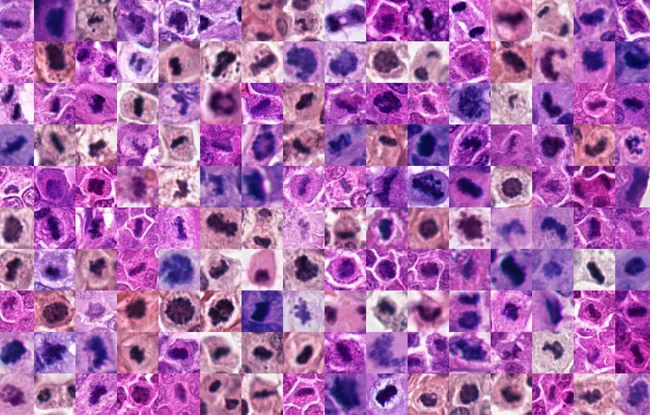- Home >
- Institut Curie News >
- Uveal melanoma: a step forward to improve patient monitoring using circulating biomarkers
Teams from Institut Curie demonstrate the benefit of using the detection of circulating tumor DNA (ctDNA) routinely for monitoring patients with metastatic uveal melanoma who are treated with immunotherapy. Recently published in the Nature Communicationsjournal, these works carried out by Dr Manuel Rodrigues, doctor and researcher, new head of the DNA Repair & Uveal Melanoma team, D.R.U.M, (Inserm U830) and Dr. Shufang Renault, deputy head of the translational research group "Circulating tumor biomarkers", open up new perspectives for optimizing the monitoring and treatment of this rare disease thanks to a personalized approach.
Uveal melanoma: a rare but aggressive disease
A rare form of cancer, uveal melanoma is the most common malignant eye tumor in adults, with about 500 to 600 new cases diagnosed each year in France. Almost a third of patients can develop metastases, usually in the liver. Being a national referral center for the treatment of this cancer, Institut Curie is equipped with cutting-edge technologies, such as proton therapy, and it conducts numerous innovative research programs in this field. Institut Curie actively participated in the clinical trial demonstrating that tebentafusp, a bispecific immunotherapy, significantly improves the survival of HLA*A02:01 patients with metastatic uveal melanoma (MUM). This new immunotherapy is now the first-line treatment for patients with HLA*A02:01.
Detection of circulating tumor DNA by ddPCR
In this context, new work has evaluated the interest of detecting DNA released by tumor cells into the bloodstream (ctDNA) in patients with MUM and treated with tebentafusp using a digital PCR (ddPCR) technique. This method was developed at Institut Curie, within the translational research group "Circulating Tumor Biomarkers (BTC)" led by Prof. François-Clément Bidard, medical oncologist, and Dr. Shufang Renault in collaboration with Dr. Marc-Henri Stern, former head of the DNA Repair & Uveal Melanoma Team at Institut Curie (Inserm U830). By tracking MUM-specific mutations, this approach makes it possible to monitor treatment responses with a highly sensitive method while being more cost-effective than traditional methods.
Promising results for patient monitoring
The study made it possible to analyze the levels of ctDNA in 69 patients with MUM who are treated in real life with tebentafusp. Before the start of treatment, 61% of patients had detectable traces of ctDNA in their plasma, which was associated with a less favorable prognosis and a reduced overall survival.
On the other hand, patients without detectable ctDNA not only had a better overall survival but also a better response to immunotherapy treatment. However, one of the most striking results is that patients with detectable ctDNA at baseline and who experienced a 90% or greater reduction in this level after 12 weeks of treatment had significantly improved survival, close to that of patients with undetectable levels at baseline. This study paves the way for a more extensive use of ctDNA as a key marker to adapt treatments in real time.
"The use of ctDNA in the monitoring of patients treated with tebentafusp represents a real evolution in the management of this disease. Combined with radiological evaluation, it allows us to better follow the evolution of patients and to adjust the treatments in a more personalized way in the future, thus improving the prospects for those with metastatic uveal melanoma. Future developments in the Circulating Tumor Biomarker laboratory could make it possible to further improve the sensitivity of the technique and perhaps even to characterize the tumor without biopsy," concludes Dr. Manuel Rodrigues.
________________________________________
Reference: Prospective assessment of circulating tumor DNA in patients with metastatic uveal melanoma treated with tebentafusp. M. Rodrigues, T. Ramtohul, A. Rampanou, J.L. Sandoval, A. Houy, V. Servois, L. Mailly-Giacchetti, G. Pierron, A. Vincent-Salomon, N. Cassoux, P. Mariani, C. Dutriaux, M. Pracht, T. Ryckewaert, J.E. Kurtz, S. Roman-Roman, S. Piperno-Neumann, F.C. Bidard, M.H. Stern, S. Renault. Nature Communications October 14, 2024 https://doi.org/10.1038/s41467-024-53145-0
MBD4, a key player in the protection against cancer
Even more recently, the researchers of the DNA Repair & Uveal Melanoma team at Institut Curie, DRUM , have published, also in Nature Communications , a work on how the DNA repair influences mutations in cancer genomes. These mutations, caused by various processes, contribute to the development of tumors by following specific patterns called "mutational signatures" that offer prospects for diagnosis and treatment.
Dr. André Bortolini-Silveira, post-doctoral researcher on the DRUM team, focused on very specific mutations (transformation of cytosine into thymine at the methylated CpG dinucleotides) of certain cancers when they are deficient in a DNA repair enzyme called MBD4. The team had already demonstrated that the germ mutations of MBD4 significantly increase the risk of cancer, in particular that of uveal melanoma (DOI : 10.1093/jnci/djaa047).
Today, Dr. Bortolini-Silveira goes one step further: the obtained results demonstrate that patients with MBD4 dysfunctions accumulate characteristic mutations at the level of DNA methylation, specific to the tissue in which the tumor appears. These mutations frequently affect key genes involved in the development of tumors (such as BAP1 and GNA11). This work also explores in detail the mutational signatures previously mistakenly attributed to MBD4 and evokes new mechanisms explaining them.
By clarifying the role of MBD4 in protection against these mutations, this study helps to further elucidate the mechanisms that promote oncogenesis.
Référence :Base-excision repair pathway shapes 5-methylcytosine deamination signatures in pan-cancer genomes. A. Bortolini Silveira, A. Houy, O. Ganier, B. Özemek, S. Vanhuele, A. Vincent-Salomon, N. Cassoux, P. Mariani, G. Pierron, S. Leyvraz, D. Rieke, A. Picca, F. Bielle, M.-L. Yaspo, M. Rodrigues, M.-H. Stern. Nature Communications, published on November 14, 2024.
DOI : https://doi.org/10.1038/s41467-024-54223-z.



